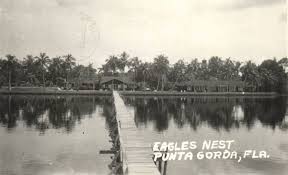
Good Day to all! Before I get started with today’s column, something interesting came up after my previous column. You may recall a portion of it dealt with Nathaniel DeCoster’s Harbor View subdivision and its streets named after the tropical fruit trees he planted. However, if you visit the area today you will find, perhaps surprisingly, Drance Street, running north and south, in the middle of the subdivision.
After the column appeared, I received an email from local attorney Jack Hackett expressing his theory that street name may have resulted from a misinterpretation of the DeSoto County plat’s details, something not necessarily unusual in the days of hand-drawn plats, when it was rerecorded after Charlotte County’s creation in 1923 and was meant to be “Orange Street”.
Upon reviewing a copy of the DeSoto County plat he provided, although very legible, I could certainly see his point when comparing individual letters in the streets’ names. Even more telling, in my view, after considering the possibility, would be the intentional absence on DeCoster’s part of an “Orange Street” in the plat when he specifically mentions planting that type of tree along with all the others that do appear. Thanks Jack, I think you’re on to something! Now, this week’s column.
Did you know Punta Gorda and Charlotte County have been great hunting and fishing destinations since their early days? On assignment for Harper’s Weekly to illustrate a story on “cracker cowboys”, renowned American western artist Frederic Sackrider Remington came to Punta Gorda, on the country’s last frontier, in January 1895. After being here a month, he wrote a close friend regaling him with stories of deer, bear, tarpon, red snapper, and ducks, wanting to know when he could be expected. The hunting and fishing led to established lodges catering to those seeking such an adventure. Although several existed over the years, two of the best known are the Eagles Nest and the Allapatchee Lodge.
The Eagles Nest began as a small cottage on the river’s south bank and the complex stood over ensuing years until severely damaged by Hurricane Ian. The site is still home to the Punta Gorda Fraternal Order of Elks.
In 1919, C. M. Carrier purchased all of Block 1 in Solana, Frederick and Anna Howard’s subdivision just east of Punta Gorda, across the street from the Howards’ beautiful home, which still stands today at the corner of Howard Street and Shore Drive. A year later, Carrier sold a portion of his property to wealthy New York resident, John Morrison, a hunting and fishing enthusiast who often visited this area.
Around 1921, Morrison completed a much larger home naming it Eagles Nest, since there was one in a nearby pine tree. He and his wife travelled extensively and furnished the home with exotic hand carved wooden pieces from around the world. In the late 1930’s, after his wife’s death, Morrison sold the Eagles Nest to folks from Ohio, James and Jeannette Kelly.
James was a professional golfer and owned a sporting goods store in Dayton. They had ended up visiting Punta Gorda by chance a few years earlier after heading to Florida on the orders of James’ doctor and, like so many others, fell in love with the place, particularly due to the fantastic hunting and fishing.
After adding dog kennels and cabins, Eagles Nest became a well-known hunting and fishing lodge, with guests such as professional golfers Sam Snead and Carey Middlecoff, and World War II hero, General Omar Bradley. Later on, son Jim also operated a summer camp for boys. I can remember when he’d bring all the campers to town on Saturday nights for a movie at my grandparents’ theater. In 1980, Jim sold the lodge to the newly formed Punta Gorda Elks and “Thank You” Elks for saving a beautiful place as long as you could! My next column will be all about Alligator Creek’s Allapatchee Lodge.
Visit Charlotte County History Collections “on-line” to view photographs of the Eagles Nest.
“Did You Know” appears, typically, every other Wednesday, courtesy of this newspaper and the Charlotte County Historical Society. The Society’s mission is to help promote and preserve Charlotte County’s rich history. We are also always looking for volunteers and interested individuals to serve as board members. If you believe our area’s history is as important as we do, please visit Charlotte County Historical Society on-line at https://cchistoricalsociety.com/, or call 941- 769-1270 for more information
Check out History Services’ yearlong project, “Telling Your Stories: History in the Parks”. It began in January 2021 with placement of the first interpretive sign “Charlotte Harbor Spa” at South County Regional Park. The last was dedicated December 15, 2021 at Centennial Park featuring Florida postcards. All dedicated signs can be viewed at online library resources. Select “Programs and Services”, then “History Services” and “Virtual Programs”.
Visit the same site to access recently released oral histories featuring 40 local folks. Select “History Services” and scroll down, or phone 941-629-7278, to find out what history related programs and videos are available.
August 29 column


